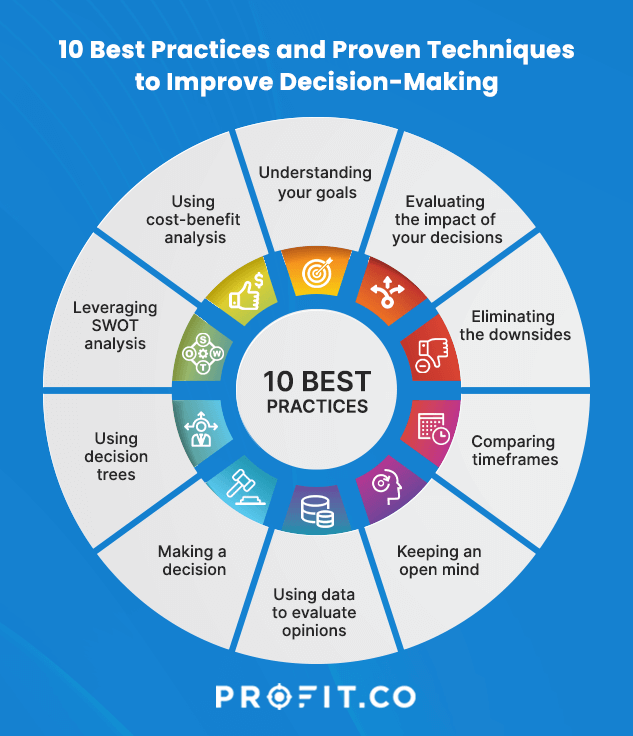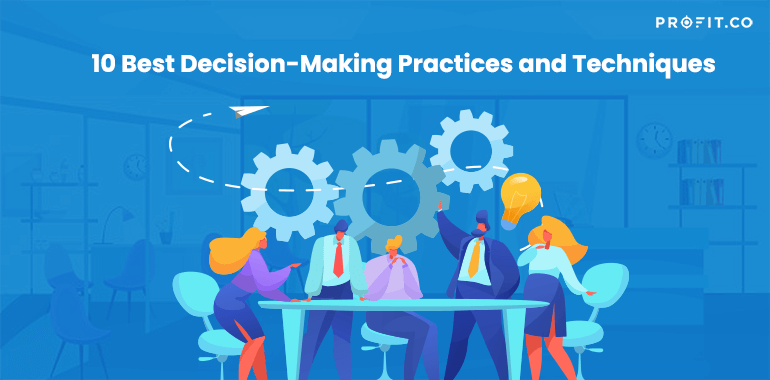Introduction
We make multiple decisions daily, potentially impacting our actions and everyone around us. Executives feel this pressure more and may develop decision fatigue as they face critical decisions with ever-increasing risk. It’s crucial to have strong decision-making abilities.
What can you do to perfect your decision-making skills?
This guide explores proven techniques and decision-making best practices to give you the confidence to make intelligent decisions within a split second.
The most important decision you make are not the things you do, but the things you decide you not to do.
Decision-Making Framework
The impact and range of decisions increase as you climb the management ladder.
Decision-making is a multifaceted framework that involves different aspects, such as:
1. Identifying the challenge
It would be best to determine which problem needs a solution before deciding. Your decision-making process will depend on a combination of various fixed choices. Remember that doing nothing or not making a decision can also be viable solutions.
2. Identifying options and alternatives
Effective decision-making best practices aim to identify all possible alternative solutions for an issue or challenge. Doing so allows you more flexibility to assess the weakness and strengths of all possible solutions.
It’s also wise to decide how much time to allocate to the decision-making process by considering the following:
- Are there benefits to making a quick decision?
- How much time do you have to make this decision?
- If you spend more time enhancing the quality of the decision, will it have any impact?
- How important is making the right decision, and what makes it essential?
- Do you have a deadline to decide, and what will happen if you miss it?
Remember that sometimes making the right decision is more impactful than making a quick decision and vice versa.
3. Evaluating the evidence
It’s essential to collect all relevant information before making a decision. Outdated, inadequate, or incorrect information increases the chances of making the wrong decision. Irrelevant information can also complicate decision-making since unnecessary factors easily become distractions.
Once your options are clear, compare the pros and cons of the decision you intend to make.
4. Evaluating the alternatives
Consider the level of risk that comes with each decision and how much risk you’re willing to take based on the following:
- Advantages of the right decision
- How severe the consequences of making the wrong decision are
- The likely outcomes and the worst-case scenario
Assessing the worst-case scenario helps you decide between a safe and risky to ensure success.
5. Implementing the final decision
The next step after making the final decision is implementing it. It would help if you devised a plan to assign tasks or roles to ensure your decision aligns with the company or business goals.
6. Evaluating the decision
Evaluating your final decision after a certain period is best to see whether it helped you achieve the intended goals.
Doing so helps you determine what works to inform future decisions.
10 Best Practices and Proven Techniques to Improve Decision-Making
Decision-making skills are similar to others, so you can learn and perfect them with time and practice.

You can enhance these skills through techniques and best practices such as:
1. Understanding your goals
You must establish what you aim to achieve or accomplish with any decision. Ensure your choices align with the business, team, and personal goals whenever possible.
2. Evaluating the impacts of your decisions
Different decisions have varying impacts, so spending equal time on all decisions is unwise.
You can start by categorizing your decisions based on their impacts on the business, you, and your team.
3. Eliminating the downsides
One effective way to reduce the time spent weighing different decisions is to eliminate the alternatives with the most significant downsides. Such choices require more support or resources and are more complex to implement in your company or business.
Another effective decision-making strategy is assessing the worst-case scenarios and choosing the most reasonable one for you or the one with the most acceptable consequences.
4. Comparing timeframes
Each decision comes with a specific timeframe. Failing to decide within this timeframe can magnify the problem, cause you to miss excellent opportunities, or affect your team and workflow. Mastering deadline management is important to stay on track and identify priorities.
Once you identify critical decisions, avoid procrastinating. Rushing vital decisions can have significant impacts, especially when resources are involved. Handle the minor decisions first and allow yourself more time to focus on impactful ones.
Ready to accelerate your expertise?
5. Keeping an open mind
Most people base decisions on assumptions, emotions, and experience. You can start the decision-making process with preferences only to discover better solutions after evaluating others’ opinions and data.
Avoid getting emotionally invested in a decision or course of action to the point where it prevents you from identifying better alternatives.
It’s also best to avoid confirmation bias, where you decide first and then hunt for logic or evidence to support it.
As Sia Mohajer cautions in his book, The Little Book of Stupidity, confirmation bias is a fundamental aspect we fail to recognize in our lives. We seek evidence to support our opinions and beliefs while excluding those contradicting them.
You can avoid this bias by identifying a problem and asking “what if” questions. Keeping an open mind and never hesitating to switch from one decision to a better one helps for clarity.
6. Using data to evaluate opinions
Our assumptions, experiences, emotions, and agendas influence our opinions. For example, business leaders often turn to emotions to guide them in financial decisions and fall victim to the sunk cost fallacy. Involving other people in critical decisions allows you deeper insights and access to different lines of thinking and viewpoints to prevent shortcomings.
These contributions enable you to make better, more informed decisions, especially for complex or challenging decisions impacting your business or company.
You can use robust tools to compare available data with recommendations and opinions for a comprehensive overview of whether the views are misleading or the data is inaccurate.
This comparison becomes a check to minimize or eliminate bias in other team members’ opinions.
7. Making a decision
In most cases, the worst thing you could do is fail to make any decision. Indecisiveness and delays often lead to lost opportunities and frustrations. If undecided, ask other team members for recommendations and compare them to data to narrow options.
8. Using decision trees
Decision trees visually map out various options and their probabilities or possible outcomes. Such diagrams make it easier to identify the best decision depending on the likelihood of different outcomes
9. Leveraging SWOT analysis
SWOT analysis can be an asset in decision-making. Identifying the threats, opportunities, weaknesses, and strengths of various options helps you evaluate the potential benefits and risks associated with each one.
10. Using cost-benefit analysis
Cost-benefit analysis helps you assess the benefits and costs of various options. Using cost-benefit analysis involves comparing each alternative’s expected benefits and costs to determine the one with the most benefits at the least cost.
FAQs
1. Is problem-solving related to decision-making?
These concepts are closely related because effective problem-solving requires identifying possible solutions and selecting the best solution. Both require the ability to systematically and logically analyze information and critical thinking skills.
2. What does effective decision-making look like?
Decision-making best practices involve:
- Identifying options
- Assessing pros and cons
- Selecting the best course of action that aligns with your business goals and values
3. Are there defined steps in decision-making?
The steps of the decision-making process vary based on the situation. Although there’s no particular order, the key steps include the following:
- Identifying the challenge
- Collecting and analyzing information about it
- Determining possible options or solutions
- Assessing the pros and cons of every choice
- Making the final decision
- Implementing your decision
Conclusion
Mastering decision-making best practices empower you to make intelligent decisions to resolve complex challenges and draw closer to your goals.
With Profit.co’s easy-to-use dashboard, you can effectively finesse your decision-making abilities and monitor your progress to become more efficient and productive.
Remember, like any other skill, practice makes perfect! Increasing your decision-making abilities takes investment but will undoubtedly lead to success.

